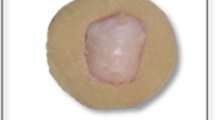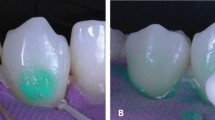Abstract
White spot lesion (WSL) infiltration has been recommended immediately after debonding of orthodontic brackets. It is however not clear if established inactive WSLs can also be masked through infiltration
Orthodontic treatment of a 19-year-old patient had to be terminated prematurely due to development of multiple WSLs of varying severity. Three months after debonding, the patient presented for lesion infiltration. After etching with 15% HCl gel and re-wetting of the dried surfaces it seemed that a good outcome could be expected. Lesion infiltration led to complete masking of less severe WSLs. The visual appearance of moderate and severe WSLs was improved but they were still visible after treatment.
Inactive WSLs may not represent an increased caries risk, but patients are often bothered esthetically. Infiltration by repeated etching might be a viable approach even for inactive WSLs. Controlled clinical trials are needed to investigate the long-term performance of this technique.
Zusammenfassung
Die Infiltration initialer kariöser Läsionen (Kreideflecke, White- Spot-Läsionen) wird unmittelbar nach der Entfernung kieferorthopädischer Brackets empfohlen. Es ist jedoch unklar, ob auch etablierte Kreideflecken durch Infiltration maskiert werden können.
Bei einem 19-jährigen Patienten musste die festsitzende orthodontische Phase wegen Auftretens multipler initial kariöser Läsionen vorzeitig beendet werden. Drei Monate nach der Entfernung der Brackets wurde der Patient zur Infiltration vorstellig. Nach dem Ätzen mit 15%igem HCl-Gel konnte durch gezieltes Wiederbefeuchten der getrockneten Zahnoberflächen das zu erwartende Ergebnis antizipiert werden. Die Infiltrationstechnik führte zur vollständigen Maskierung weniger stark ausgeprägter Kreideflecke. Stärker demineralisierte Läsionen wurden optisch verbessert, waren aber nach der Behandlung noch immer sichtbar.
Inaktive Kreideflecke sprechen nicht unbedingt für ein erhöhtes Kariesrisiko, aber Patienten stören sich häufig an der kosmetischen Einbuße. Die Infiltration dieser Läsionen mit multiplen Ätzschritten könnte auch für inaktive Kreideflecke sinnvoll sein. Es fehlen jedoch Langzeitdaten aus klinischen Untersuchungen zur Validierung dieser Methode.
Similar content being viewed by others
References
Andersson A, Skold-Larsson K, Hallgren A, et al. Effect of a dental cream containing amorphous cream phosphate complexes on white spot lesion regression assessed by laser fluorescence. Oral Health Prev Dent 2007;5:229–33.
Ardu S, Castioni NV, Benbachir N, Krejci I. Minimally invasive treatment of white spot enamel lesions. Quintessence Int 2007;38:633–6.
Arnold WH, Cerman M, Neuhaus K, Gaengler P. Volumetric assessment and quantitative element analysis of the effect of fluoridated milk on enamel demineralization. Arch Oral Biol 2003;48:467–73.
Backer Dirks O. Posteruptive changes in dental enamel. J Dent Res 1966;45:503–11.
Bailey DL, Adams GG, Tsao CE, et al. Regression of post-orthodontic lesions by a remineralizing cream. J Dent Res 2009;88:1148–53.
Benson PE, Parkin N, Millett DT, et al. Fluorides for the prevention of white spots on teeth during fixed brace treatment. Cochrane Database Syst Rev 2004:CD003809.
Bergstrand F, Twetman S. Evidence for the efficacy of various methods of treating white-spot lesions after debonding of fixed orthodontic appliances. J Clin Orthod 2003;37:19–21.
Croll TP, Cavanaugh RR. Hydrochloric acid-pumice enamel surface abrasion for color modification: results after six months. Quintessence Int 1986;17:335–41.
Derks A, Katsaros C, Frencken JE, et al. Caries-inhibiting effect of preventive measures during orthodontic treatment with fixed appliances. A systematic review. Caries Res 2004;38:413–20.
Iijima Y, Takagi O. In situ acid resistance of in vivo formed white spot lesions. Caries Res 2000;34:388–94.
Leach SA, Lee GT, Edgar WM. Remineralization of artificial carieslike lesions in human enamel in situ by chewing sorbitol gum. J Dent Res 1989;68:1064–8.
Paris S, Meyer-Lueckel H, Kielbassa AM. Resin infiltration of natural caries lesions. J Dent Res 2007;86:662–6.
Paris S, Meyer-Lueckel H, Colfen H, Kielbassa AM. Penetration coefficients of commercially available and experimental composites intended to infiltrate enamel carious lesions. Dent Mater 2007;23:742–8.
Paris S, Meyer-Lueckel H. Masking of labial enamel white spot lesions by resin infiltration - a clinical report. Quintessence Int 2009;40:713–8.
Stecksen-Blicks C, Renfors G, Oscarson ND, et al. Caries-preventive effectiveness of a fluoride varnish: a randomized controlled trial in adolescents with fixed orthodontic appliances. Caries Res 2007;41:455–9.
Sudjalim TR, Woods MG, Manton DJ, Reynolds EC. Prevention of demineralization around orthodontic brackets in vitro. Am J Orthod Dentofacial Orthop 2007;131:705 e1-9.
Tong LS, Pang MK, Mok NY, et al. The effects of etching, micro-abrasion, and bleaching on surface enamel. J Dent Res 1993;72:67–71.
Author information
Authors and Affiliations
Corresponding author
Rights and permissions
About this article
Cite this article
Neuhaus, K.W., Graf, M., Lussi, A. et al. Late Infiltration of Post-orthodontic White Spot Lesions. J Orofac Orthop 71, 442–447 (2010). https://doi.org/10.1007/s00056-010-1038-0
Received:
Accepted:
Published:
Issue Date:
DOI: https://doi.org/10.1007/s00056-010-1038-0




